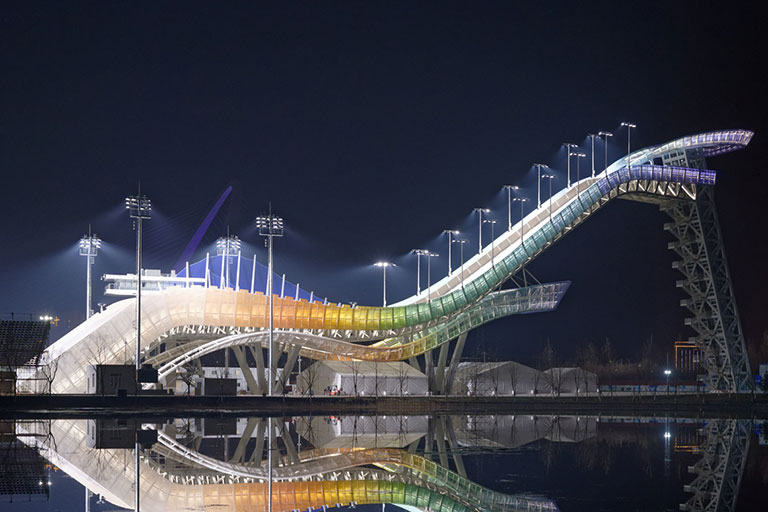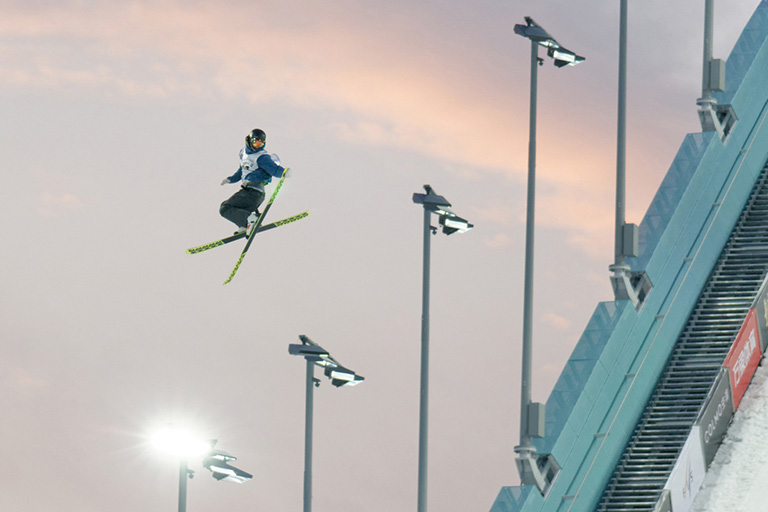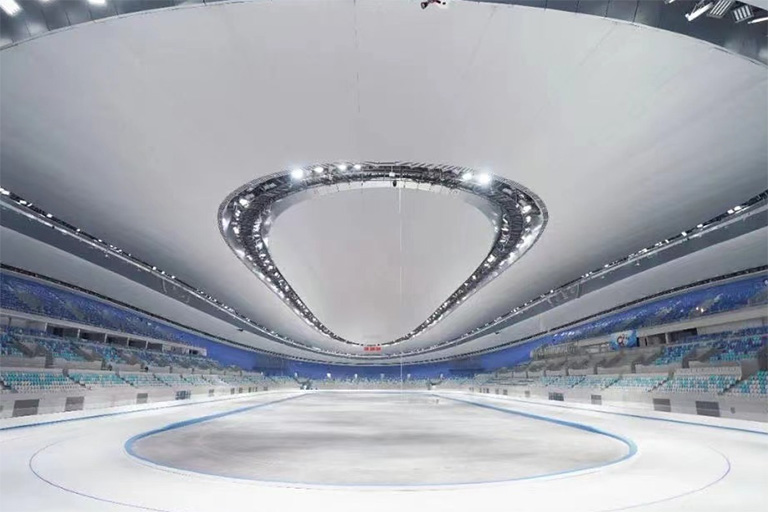As part of its hosting of the Beijing 2022 Olympics, China has been investing heavily in winter sports facilities, that include regenerated industrial sites and clean energy.
China is hoping to encourage 300 million people to take part in winter sports through its ambitious infrastructure projects, including building the world’s first permanent ‘Big Air’ facility in Shougang to the west of Beijing.
First established in 1919, the Shougang site was the country’s first state-owned steel production facility, seeing millions of tonnes manufactured there and kick-starting China’s journey to becoming the world’s number one producer of steel.
Now the reclaimed steel-making facility offers a potent symbol of regeneration at the Beijing 2022 Winter Olympics through being repurposed as a sports, culture, and tourism hub.
This move to create a new purpose for the Shougang site was also informed by the city of Beijing’s ambitious plans to tackle urban air pollution ahead of the 2008 summer Olympics. Steel production was ramped down over time, allowing the industrial site to be repurposed into the multifunctional culture and entertainment hub it is today.
 Built from structural steel, Shougang is the world’s first permanent Big Air facility
Built from structural steel, Shougang is the world’s first permanent Big Air facility
Reclaiming the past to build the future
Used as a training facility for Chinese athletes ahead of the winter games, the former industrial complex has been converted to include short track speed skating, figure skating, ice hockey and curling, and even houses the Beijing 2022 Organizing Committee offices.
The site, which covers 5.5km² and can hold up to 8,000 spectators, still retains many of the original infrastructure and machinery on site, offering a unique contrast to the grassy lawns, abundant plant life and large glass ponds that cover the grounds.
“Shougang Park will be for a long time a symbol of urban regeneration” – Marie Sallois, IOC Director for Sustainability.
Rising 61 metres from among the greenery to draw near level with the plant’s old cooling towers is Shougang’s most impressive addition – its 164-metre big air ramp. Resembling a glittering high-heeled shoe, athletes from around the world have been performing dazzling jumps and flips from it against a uniquely regenerated industrial backdrop.
 China hopes its new facilities will inspire 300 million people to take up winter sports
China hopes its new facilities will inspire 300 million people to take up winter sports
At the base of the jump are seats for 2,500 spectators, with the set-up flexible so that it can accommodate concerts and shows in the summer months. Steel doesn’t just sit at the heart of the site’s past, with the big air jump made largely from structural steel and temporary steel stands used to expand the capacity for larger events such as the Olympics, the material is very much part of Shougang’s present.
“Shougang Park will be for a long time a symbol of urban regeneration,” said Marie Sallois, IOC Director for Sustainability. “It is an impressive example showing how with creativity, drive and innovation we can transform city landscapes into more liveable, citizen-friendly and greener spaces.”
A greener winter Olympics
With Beijing 2022 the first Winter Olympics to be 100% powered by clean energy, the city’s sporting venues set a new standard for sustainability. The National Speed Skating Oval, known as the Ice Ribbon, is a beautiful, modern steel-built arena that embodies this greener approach.
Located near the iconic Bird’s Nest stadium, the Ice Ribbon’s beautiful curving form is constructed from 23,000 tons of high-quality steel, provided by HBIS. The 12,000-seat venue was constructed in an incredibly ambitious time frame, with the ability for the ribbon structure’s arcing precision steel components to be manufactured off-site being crucial in completing the project on schedule.
The Ice Ribbon also operates a carbon dioxide transcritical direct cooling ice-making system that is reliant on China Baowu stainless steel pipes, stainless threaded steel bars, stainless steel plates and other materials for its main pipeline.
 The Ice Ribbon uses a stainless-steel-built carbon dioxide ice making system
The Ice Ribbon uses a stainless-steel-built carbon dioxide ice making system
This novel approach to ice making improves energy efficiency compared with traditional refrigerants, and all waste heat generated can be recovered and reused, saving thousands of kilowatts of electricity.
Train to win
The Beijing-Zhangjiakou high-speed railway connects to the two co-host cities on the ‘Winter Olympic Line’, moving spectators between the sites of the venues in just 47 minutes at speeds of 350kph. Called the ‘first intelligent high-speed railway’, its autonomous system replaces human drivers and improves energy efficiency by up to 7%.
The train itself is an electric multiple unit (EMU) bullet train, formed of eight cars and with a full 5G live broadcast studio contained onboard. More than 260,000 tons of HBIS steel was used across the entire railway project, with this high-speed transport link forming a powerful and enduring Olympic legacy.
With China already seeing gold medal success at the 2022 Winter Olympics, Beijing hopes that the Ice Ribbon and Shougang sites can be symbols not just of regeneration and the country’s industrial heritage, but also of athletic excellence and its sporting future.